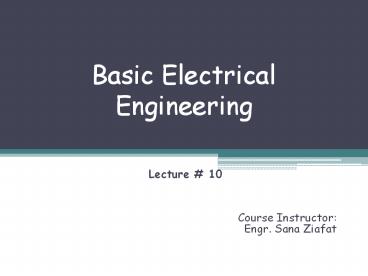Basic Electrical Engineering - PowerPoint PPT Presentation
Title:
Basic Electrical Engineering
Description:
Basic Electrical Engineering Lecture # 10 Course Instructor: Engr. Sana Ziafat Agenda Planner vs Non planner circuits Node analysis Branches and Nodes Branch ... – PowerPoint PPT presentation
Number of Views:194
Avg rating:3.0/5.0
Title: Basic Electrical Engineering
1
Basic Electrical Engineering
- Lecture 10
- Course Instructor
- Engr. Sana Ziafat
2
Agenda
- Planner vs Non planner circuits
- Node analysis
3
Branches and Nodes
Branch elements connected end-to-end, nothing
coming off in between (in series) Node plac
e where elements are joinedincludes entire wire
4
Nodal Analysis
- Kirchhoffs current law is used to develop the
method referred to as nodal analysis - A node is defined as a junction of two or more
branches - Application of nodal analysis
- Determine the number of nodes within the network.
- Pick a reference node, and label each remaining
node with a subscript value of voltage V1, V2,
and so on.
5
Nodal Analysis
- Apply Kirchhoffs current law at each node except
the reference. Assume that all unknown currents
leave the node for each application of
Kirchhoffs current law. In other words, for
each node, dont be influenced by the direction
that an unknown current for another node may have
had. Each node is to be treated as a separate
entity, independent of the application of
Kirchhoffs current law to the other nodes. - Solve the resulting equation for the nodal
voltages.
6
Nodal Analysis
- On occasion there will be independent voltage
sources in the network to which nodal analysis is
to be applied. If so, convert the voltage source
to a current source (if a series resistor is
present) and proceed as before or use the
supernode approach - Assign a nodal voltage to each independent node
of the network. - Mentally replace independent voltage sources with
short-circuits. - Apply KCL to the defined nodes of the network.
- Relate the defined nodes to the independent
voltage source of the network, and solve for the
nodal voltages.
7
Nodal Analysis
- Choose a reference node and assign a subscripted
voltage label to the (N 1) remaining nodes of
the network. - The number of equations required for a complete
solution is equal to the number of subscripted
voltages (N 1). Column 1 of each equation is
formed by summing the conductances tied to the
node of interest and multiplying the result by
that subscripted nodal voltage.
8
Nodal Analysis(Format Approach)
- We must now consider the mutual terms that are
always subtracted form the first column. It is
possible to have more than one mutual term if the
nodal voltage of current interest has an element
in common with more than one nodal voltage. Each
mutual term is the product of the mutual
conductance and the other nodal voltage tied to
that conductance.
9
Nodal Analysis(Format Approach)
- The column to the right of the equality sign is
the algebraic sum of the current sources tied to
the node of interest. A current source is
assigned a positive sign if it supplies current
to a node and a negative sign if it draws current
from the node. - Solve the resulting simultaneous equations for
the desired voltages.
10
Node Voltages
- The voltage drop from node X to a reference node
(ground) is called the node voltage Vx. - Example
11
Nodal Analysis Method
- 1. Choose a reference node ( ground, node 0)
- (look for the one with the most connections,
- or at the bottom of the circuit diagram)
- 2. Define unknown node voltages (those not
connected to ground by voltage sources). - 3. Write KCL equation at each unknown node.
- How? Each current involved in the KCL equation
will either come from a current source (giving
you the current value) or through a device like a
resistor. - If the current comes through a device, relate the
current to the node voltages using I-V
relationship (like Ohms law). - 4. Solve the set of equations (N linear KCL
equations for N unknown node voltages).
12
Example
What if we used different ref node?
node voltage set ?
Va
R1
IS
V1
R
-
2
? reference node
- Choose a reference node.
- Define the node voltages (except reference node
and the one set by the voltage source). - Apply KCL at the nodes with unknown voltage.
- Solve for Va and Vb in terms of circuit
parameters.
13
Example
R
1
Va
R
5
R
I
3
1
V
V
R
R
2
1
2
4
14
Q A































